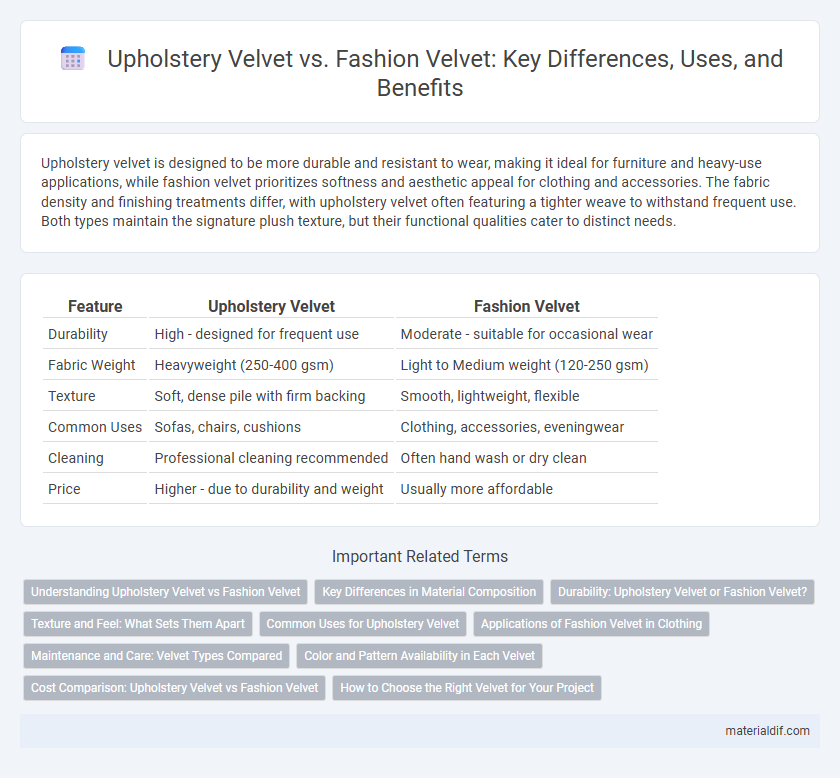Upholstery velvet is designed to be more durable and resistant to wear, making it ideal for furniture and heavy-use applications, while fashion velvet prioritizes softness and aesthetic appeal for clothing and accessories. The fabric density and finishing treatments differ, with upholstery velvet often featuring a tighter weave to withstand frequent use. Both types maintain the signature plush texture, but their functional qualities cater to distinct needs.
Table of Comparison
| Feature | Upholstery Velvet | Fashion Velvet |
|---|---|---|
| Durability | High - designed for frequent use | Moderate - suitable for occasional wear |
| Fabric Weight | Heavyweight (250-400 gsm) | Light to Medium weight (120-250 gsm) |
| Texture | Soft, dense pile with firm backing | Smooth, lightweight, flexible |
| Common Uses | Sofas, chairs, cushions | Clothing, accessories, eveningwear |
| Cleaning | Professional cleaning recommended | Often hand wash or dry clean |
| Price | Higher - due to durability and weight | Usually more affordable |
Understanding Upholstery Velvet vs Fashion Velvet
Upholstery velvet features heavier weight and higher durability, designed to withstand frequent use and resist wear, making it ideal for furniture and home decor applications. Fashion velvet offers a lighter, softer texture with greater fluidity, emphasizing comfort and style suited for garments and accessories. Understanding the difference in fiber content, weave density, and finishing treatments helps select the appropriate velvet type for specific purposes.
Key Differences in Material Composition
Upholstery velvet is typically made from heavier fibers such as cotton, polyester, or a blend, designed for durability and resistance to wear and tear, making it ideal for furniture covering. Fashion velvet, often composed of silk, rayon, or lightweight synthetic fibers, prioritizes softness and drape for clothing and accessories. The key difference lies in upholstery velvet's robust weave and weight, which contrasts with the finer, more delicate fiber structure in fashion velvet.
Durability: Upholstery Velvet or Fashion Velvet?
Upholstery velvet typically offers superior durability compared to fashion velvet due to its heavier weight and denser weave designed for wear resistance. Fashion velvet, while luxurious and soft, is generally lighter and less durable, making it more suitable for clothing than high-traffic upholstery. Choosing upholstery velvet ensures long-lasting performance on furniture, resisting abrasion and daily use better than fashion velvet.
Texture and Feel: What Sets Them Apart
Upholstery velvet features a denser, thicker pile designed for durability and comfort, providing a plush and luxurious feel ideal for furniture. Fashion velvet is lighter with a finer texture, offering a soft, smooth finish that drapes elegantly on garments. The key difference lies in upholstery velvet's robust texture versus fashion velvet's delicate suppleness, catering to their distinct applications.
Common Uses for Upholstery Velvet
Upholstery velvet is primarily used in furniture design for sofas, armchairs, and cushions due to its durability and heavy fabric weight compared to fashion velvet. It offers a soft texture while withstanding wear and tear, making it ideal for high-traffic areas in residential and commercial interiors. Common applications include classic and contemporary upholstered pieces, wall panels, and headboards that require a luxurious, long-lasting finish.
Applications of Fashion Velvet in Clothing
Fashion velvet is primarily used in clothing due to its soft texture and rich appearance, making it ideal for evening wear, dresses, and luxury fashion items. Its lightweight construction and flexibility allow for comfortable wear and intricate designs, enhancing the aesthetic appeal of garments. Unlike upholstery velvet, which focuses on durability, fashion velvet prioritizes drape and elegance suitable for high-end apparel.
Maintenance and Care: Velvet Types Compared
Upholstery velvet demands regular vacuuming and gentle spot cleaning with mild detergent to preserve its durability and texture, making it ideal for heavy-use furniture. Fashion velvet often requires delicate hand washing or dry cleaning to maintain its softness and vibrancy, as it is typically lighter and more prone to wear. Both types benefit from avoiding direct sunlight and high heat to prevent fading and fiber damage, but upholstery velvet generally withstands more rigorous cleaning methods.
Color and Pattern Availability in Each Velvet
Upholstery velvet offers a wide range of rich, deep colors and classic patterns designed to complement home decor, featuring durability to withstand daily use. Fashion velvet tends to have a broader spectrum of vibrant and trendy colors with intricate or bold patterns, catering to seasonal styles and personal expression. The color palette in fashion velvet often includes unique hues and gradient effects not typically found in upholstery velvet, which prioritizes timeless tones and subtle patterns.
Cost Comparison: Upholstery Velvet vs Fashion Velvet
Upholstery velvet typically costs more than fashion velvet due to its heavier weight, durability, and specialized fabric treatments designed to withstand frequent use. Fashion velvet, made from lighter materials, is more affordable but less durable, making it ideal for clothing rather than furniture. The price difference often reflects the intended use, with upholstery velvet averaging 30-50% higher costs per yard compared to fashion velvet.
How to Choose the Right Velvet for Your Project
Upholstery velvet features a durable weave with a dense pile that resists wear, making it ideal for furniture and home decor projects requiring long-term use and easy maintenance. Fashion velvet typically has a lighter weight, softer texture, and more luxurious sheen, perfect for garments and accessories that benefit from drape and elegance. Selecting the right velvet depends on project needs: prioritize upholstery velvet for durability and resilience, and fashion velvet for softness and visual appeal.
Upholstery Velvet vs Fashion Velvet Infographic

 materialdif.com
materialdif.com